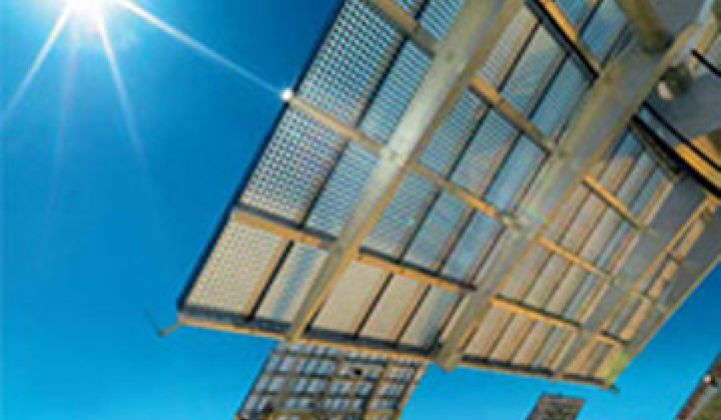Concentrated photovoltaic (CPV) solar power systems have the potential to be more efficient and perform better at high heat and high DNI conditions than flat plate solar.
CPV has received an enormous amount of press and VC funding for its potential -- but has not yet translated that potential to actual steel in the ground and electrons in wires.
That might be changing.
What's it going to take to move CPV out of PowerPoints and into power plants? A good start would be having PPAs in place at market referent pricing on large-scale projects that actually get built and interconnected.
Here's one project that has the potential to check off those boxes:
Soitec, the recent acquirer of Concentrix' concentrated photovoltaic (CPV) product, was selected by Tenaska Solar Ventures for a 150-megawatt solar project for San Diego Gas & Electric.
The CPV solar power plant, known as Imperial Solar Energy Center (ISEC) West, will be built on a 1057-acre former farmland site in southern California’s western Imperial County; completion is targeted in 2015. The plant, if active today, would be the largest CPV power station in operation. CPV technology requires no water for ongoing operations, an important consideration for the water-constrained Imperial Valley. In addition, construction of the Sunrise Powerlink transmission line has initiated a surge of new wind and big solar projects in the Imperial Valley area.
To support the project, Soitec will build a 200-megawatt-capacity factory in the San Diego area that would create hundreds of jobs.
Before we pop the champagne corks, it's important to realize that all of this -- the project and the factory -- depends on a U.S. DOE loan guarantee.
I spoke with Hansjörg Lerchenmüller, the boss of the customer side of Soitec’s CPV unit. He said, "We feel quite strong that this will go through."
The 25-year PPA is between SDE&G and Tenaska. Tenaska is the project developer with "eight gigawatts of conventional energy under operation" although "they have also become very active and successful in renewable energy," according to Lerchenmüller.
Note that although companies like Solar Junction, Cyrium, Semprius, and JDSU have made advances in the triple-junction solar cell that lies at the heart of the CPV system, Soitec has their own home-grown triple-junction PV cell technology. Soitec uses ion-implant technology to allow very thin layers to be separated from wafers. This means that optical, electrical and mechanical lattice structure constraints are no longer as tightly linked in the growth of a triple-junction cell.
Lerchenmüller said that Soitec is targeting 50 percent efficiency in their semiconductors. That exceeds current world record numbers by about eight percentage points and would result in a better levelized cost of energy (LCOE), while also decreasing the amount of heat that has be scrubbed off.
Ion implant technology, for a variety of PV process steps, really seems to be on the lips of many in the solar field, from Silicon Genesis to Suniva to Varian.
Other CPV vendors with some big projects in the pipeline include Amonix, SolFocus, and Emcore. Smaller entrants might include GreenVolts.
Last week, we heard from investors and technologists on the future of CPV at Greentech Media's Solar Summit. Erik Straser of MDV sees CPV as a "5- or 6-dimensional strike zone" where it's extremely challenging to get the thermal, mechanical, optical and cost issues in line. Peter Shannon of Firelake Capital sees CPV challenged by the continuing price plunge of c-Si, and Scott Stephens of the DOE's solar manufacturing team saw things differently. He was "bullish on CPV."
We'll know more about the loan guarantee verdict in a couple of months.



